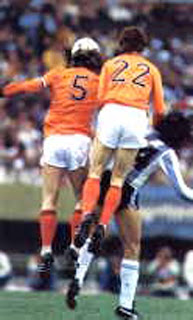A sample from Argentina – Brazil. White paper everywhere, but nobody made fuss about it. Vuvuzelas were big problem in 2006 and were banned. No such ideas in 1978.
For the first time national team had to play with borrowed shirts at World Cup finals.
France donning shirts belonging to Kimberley after the absence of their own was discovered. France in green and white stripes – unique moment.
Players with plaster casts were not exactly something new, but it was rare occurrence. Technically, forbidden by rules, as objects endangering other players, but in the gray area. The rule was enforced at the final – to the irritation of Holland, seeing deliberate move in favour of the hosts.
The controversial plaster cast on the right hand of Rene van de Kerkhof. No problem in earlier games, but had to be removed before the start of the final. Rules are rules, or nasty move to irritate the Dutch and thus to provide an advantage to Argentina? Opinions still differ.
As ever, young and old players were present at the finals. The youngest belonged to Poland:
Andrzej Iwan, the 18-years old striker made his appearance against Tunisia. Mennotti did not risk to include Maradona in his squad, but Jacek Gmoch not only included Iwan, but used him as well.
The oldest player – Jan Jongbloed, the Dutch goalkeeper.
Shattered Jongbloed after the lost final – his second. At 37 years, he had no chance for another run. Given his abilities, it was a miracle he played at 2 World Cup finals.
Very rarely a player scores for both teams in a match. Ernie Brandts of Holland managed that against Italy – he gave the lead to Italy in the 19th minute and equalized in the 50th minute.
Brandts, number 22, helping Krol to clear the ball from the vicinity of the Dutch net. Perhaps Brandts exemplified best the new type of universal player, equally suitable for any position, fit, determined, competent, and a soldier, not a star: known as a striker before the finals, Brandts was listed is defender for the World Cup. Originally a deep reserve not expected to play, he was fielded by Happel when things looked desperate – and played well.
Speaking of goals, a benchmark was reached in 1978 – the 1000th goal was scored at World Cup finals.
Rob Rensenbrink had the honour of scoring the 1000th goal – against Scotland. It the opening goal of the match, scored from a penalty shot. Alas, Holland lost at the end and Rensenbrink was outshined by the Archie Gemmill scoring the best goal at the 1978 World Cup.
And another record was bettered at the finals – Bjorn Nordqvist, already the most capped national team player of all time, added three more games.
Bjorn Norqvist rounded his appearances for Sweden to 115. At 36, he was not quitting professional football yet, but only the national team. He was constant feature for so long, it is difficult to establish who captained Sweden before him.
And yet another significant moment, which happened shortly after the finals: English clubs signed foreign players.
Tottenham Hotspur signed 2 fresh World champions – Ricardo Villa, left, and Osvaldo Ardiles. Many people were – and still are – confused, thinking that England finally lifted a ban on imports. In fact, there was never a prohibition – the main obstacle was obtaining a working permit, still existing today. This was added to the real problem: English arrogance. The general opinion for years was that foreigners simply cannot the English game. Foreign players, however, were imported in small numbers until the end of the 1960s. The following drought confused observers, but in any case Tottenham Hotspur took a big risk.
They were soon followed by Birmingham City, signing Alberto Tarantini.
One of the best defenders at the finals, Tarantini was curiosity as well – for the first time in football history, there was world champion not playing for a club. For months the only football Tarantini played was for Argentina. His training also was done only with the national team. However, it was strange to see a player, rising to stardom at the finals, to sign for quite a modest club. In England he was not precisely received wormly: world champion he was, but the British were highly skeptical about his ability to play even for a club normally playing hide and seek with relegation.
But the English market for foreigners got a jump-start. International buying and selling of players was particularly active after World Cup finals – and new countries entered, or re-entered: Eastern European countries – Hungary and Czechoslovakia. Slowly, carefully, without much information given, and mostly importing oldish 'mature' players.
At the end, what remained were memorable pictures of Argentine triumph:
Mario Kempes, scoring against Holland at the final and igniting Argentine passions.
World champions – at last, and for the last time. For the last time in some important sense: 1978 was the last championship in classic 16-team format. An end of an era. Argentina closed it.
.JPG)











.jpg)
